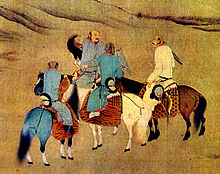
Back Khitans AN شعب الخيتان Arabic Kitán AST Xitaylar Azerbaijani خیتایلار AZB Кидандар Bashkir Кідані Byelorussian Кидани Bulgarian Khitan Catalan خیتان CKB
 Depiction of Khitans by Hugui (胡瓌, 9th/10th century), hunting with eagles | |
| Regions with significant populations | |
|---|---|
| East and Central Asia | |
| Languages | |
| Khitan, Middle Chinese | |
| Religion | |
| Majority: Chinese Buddhism Minorities: Shamanism, Tengriism, Christianity, Islam | |
| Related ethnic groups | |
| Mongols, Daur |
| History of Manchuria |
|---|
 |
The Khitan people (Khitan small script: ![]() ; Chinese: 契丹; pinyin: Qìdān) were a historical nomadic people from Northeast Asia who, from the 4th century, inhabited an area corresponding to parts of modern Mongolia, Northeast China and the Russian Far East.
; Chinese: 契丹; pinyin: Qìdān) were a historical nomadic people from Northeast Asia who, from the 4th century, inhabited an area corresponding to parts of modern Mongolia, Northeast China and the Russian Far East.
As a people descended from the proto-Mongols through the Xianbei,[1][2] Khitans spoke the now-extinct Khitan language, a Para-Mongolic language related to the Mongolic languages.[3] The Khitan people founded and led the Liao dynasty (916–1125), which dominated a vast area of Siberia, Mongolia and Northern China. The Khitans of the Liao dynasty used two independent writing systems for their language: Khitan small script and Khitan large script.
After the fall of the Liao dynasty in 1125 following the Jurchen invasion, many Khitans followed Yelü Dashi's group westward to establish the Qara Khitai or Western Liao dynasty, in Central Asia, which lasted nearly a century before falling to the Mongol Empire in 1218. Other regimes founded by the Khitans included the Northern Liao, Eastern Liao and Later Liao in China, as well as the Qutlugh-Khanid dynasty in Persia. The modern-day Daur people, a recognized minority ethnic group in Northeast China, are the genetic descendants of Khitans.[4]
The historical European name for China, Cathay, originates from the word Khitan.
- ^ "China's Liao Dynasty". Asia Society.
- ^ Xu Elina-Qian (2005). Historical Development of the Pre-Dynastic Khitan. University of Helsinki. p. 99. quote: "According to Gai Zhiyong's study, Jishou is identical with Qishou, the earliest ancestor of the Khitan; and Shihuai is identical to Tanshihuai, the Xianbei supreme chief in the period of the Eastern Han (25–220). Therefore, from the sentence "His ancestor was Jish[ou] who was derived from Shihuai" in the above inscription, it can be simply seen that the Khitan originated from the Xianbei. Since the excavated inscription on memorial tablet can be regarded as a firsthand historical source, this piece of information is quite reliable."
- ^ Janhunen, Juha (2006). "Para-Mongolic". In Janhunen, Juha (ed.). The Mongolic Languages. Routledge. p. 393 of pp. 391–402.
- ^ Li Jinhui (2 August 2001). "DNA Match Solves Ancient Mystery". china.org.cn.